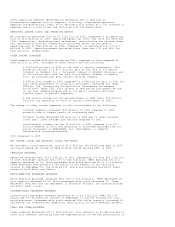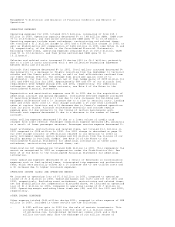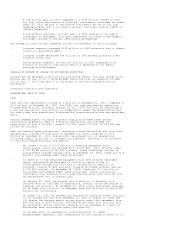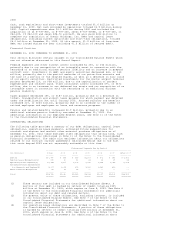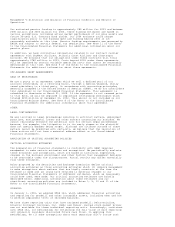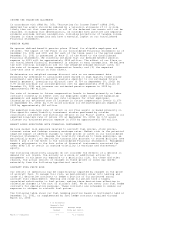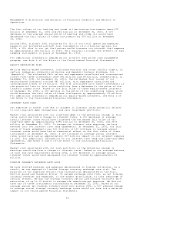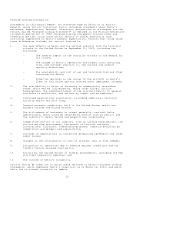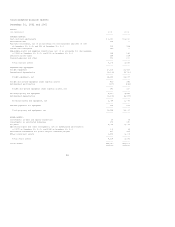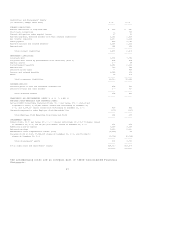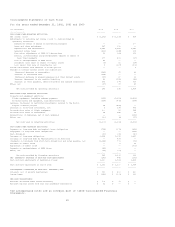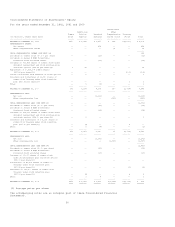Delta Airlines 2002 Annual Report Download - page 125
Download and view the complete annual report
Please find page 125 of the 2002 Delta Airlines annual report below. You can navigate through the pages in the report by either clicking on the pages listed below, or by using the keyword search tool below to find specific information within the annual report.Management's Discussion and Analysis of Financial Condition and Results of
Operations
Our estimated pension funding is approximately $80 million for 2003 and between
$350 million and $450 million for 2004. These funding estimates are based on
various assumptions, including actual market performance of our plan assets and
future 30-year U.S. Treasury bond yields. Our 2004 estimate could change
significantly prior to the funding date and funding beyond 2004 is not
reasonably estimable at this time. Pension funding requirements are governed by
ERISA and subject to certain federal tax regulations. See Note 11 of the Notes
to the Consolidated Financial Statements for additional information about our
pension plans.
In addition, we have contractual obligations related to our contract carrier
agreements with SkyWest Airlines, Atlantic Coast Airlines and Chautauqua
Airlines. We estimate that our obligations under these contracts will total
approximately $780 million in 2003. Costs beyond 2003 under these agreements
will be impacted by certain variable operating costs that cannot be reasonably
determined at this time. See Note 9 of the Notes to the Consolidated Financial
Statements for additional information about these agreements.
OFF-BALANCE SHEET ARRANGEMENTS
SALE OF RECEIVABLES
We are a party to an agreement under which we sell a defined pool of our
accounts receivable, on a revolving basis, through a special-purpose, wholly
owned subsidiary to a third party. In accordance with accounting principles
generally accepted in the United States of America (GAAP), we do not consolidate
this subsidiary in our Consolidated Financial Statements. This agreement is
scheduled to terminate on March 31, 2003. If the agreement is not renewed prior
to this date, we will be required to repurchase outstanding receivables which
totaled $250 million at December 31, 2002. This amount is not included on our
Consolidated Balance Sheets. See Note 8 of the Notes to the Consolidated
Financial Statements for additional information about this agreement.
OTHER
LEGAL CONTINGENCIES
We are involved in legal proceedings relating to antitrust matters, employment
practices, environmental issues and other matters concerning our business. We
cannot reasonably estimate the potential loss for certain legal proceedings
because, for example, the litigation is in its early stages or the plaintiff
does not specify damages being sought. Although the ultimate outcome of these
matters cannot be predicted with certainty, we believe that the resolution of
these actions will not have a material adverse effect on our Consolidated
Financial Statements.
APPLICATION OF CRITICAL ACCOUNTING POLICIES
CRITICAL ACCOUNTING ESTIMATES
The preparation of financial statements in conformity with GAAP requires
management to make certain estimates and assumptions. We periodically evaluate
these estimates and assumptions, which are based on historical experience,
changes in the business environment and other factors that management believes
to be reasonable under the circumstances. Actual results may differ materially
from these estimates.
Rules proposed by the Securities and Exchange Commission define critical
accounting estimates as those accounting estimates which (1) require management
to make assumptions about matters that are highly uncertain at the time the
estimate is made and (2) would have resulted in material changes to our
Consolidated Financial Statements if different estimates, which we reasonably
could have used, were made. Our critical accounting estimates are briefly
described below. Additional information about these estimates and our
significant accounting policies are included in Notes 1, 5, 10 and 11 of the
Notes to the Consolidated Financial Statements.
GOODWILL
On January 1, 2002, we adopted SFAS 142, which addresses financial accounting
and reporting for goodwill and other intangible assets, including when and how
to perform impairment tests of recorded balances.
We have three reporting units that have assigned goodwill: Delta-mainline,
Atlantic Southeast Airlines, Inc. (ASA) and Comair. Quoted stock market prices
are not available for these individual reporting units. Accordingly, consistent
with SFAS 142, our methodology for estimating the fair value of each reporting
unit primarily considers discounted future cash flows. In applying this
methodology, we (1) make assumptions about each reporting unit's future cash


